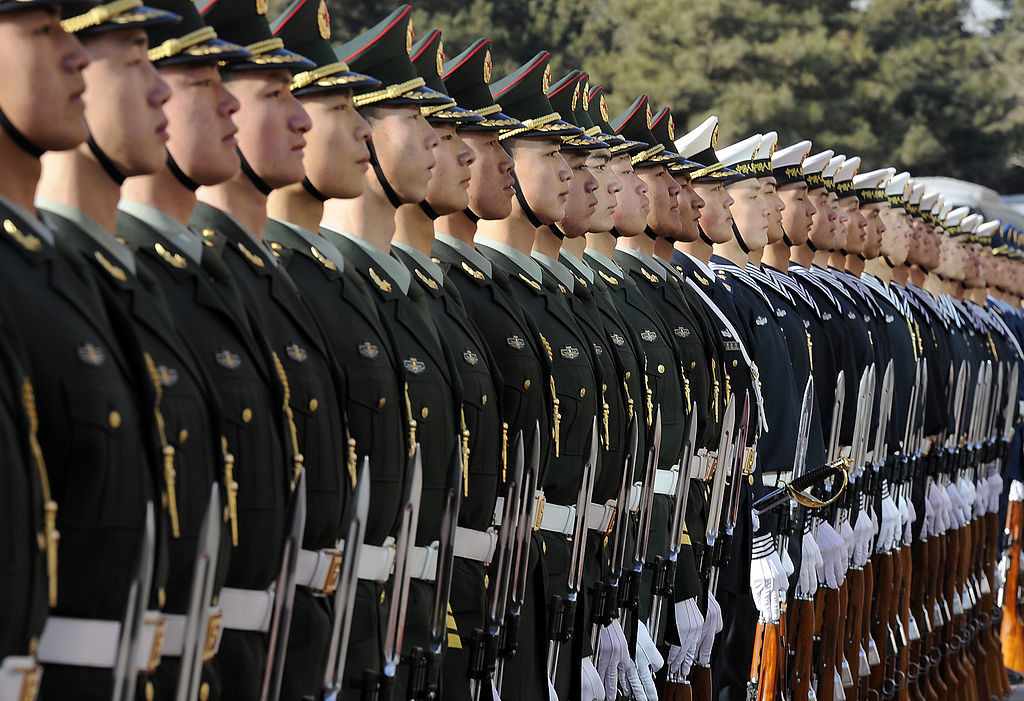Military modernisation of the PLA and factors of its undermining by the US
Modernisation of the PLA is carried out on the basis of tactics based on the brigade
RUSSTRAT Institute
China’s rapid build-up of its military power is based on Xi Jinping’s goal to complete the main areas of modernisation of the People’s Liberation Army (PLA) by 2035, and by 2049 to turn China into a “world-class” military power capable of waging and winning wars against the strongest military powers.
The main military opponent of China is the United States, the modernisation of the PLA is carried out in order to win an armed confrontation with the United States in the Taiwan Strait during the military operation to annex the Republic of China (Taiwan Island) to the People’s Republic of China (PRC).
The PLA structure is as follows: ground forces, naval forces, air forces, missile forces, strategic support forces, and logistics support forces. Modernisation of the PLA was started in the second half of the 1990s under Jiang Zemin, the reason for the start of modernisation was the task of a military solution to the problem of Taiwan’s annexation.
The planned confrontation with the United States automatically led China to the need to develop the PLA and the Chinese military-industrial complex to a level capable of ensuring superiority over the Pentagon in the South China Sea in particular and in the entire Southeast Asia as a whole. The battle for Taiwan was turning into not only a battle for the Strait, but also a battle for the status of the world’s hegemon.
Modernisation of the PLA intensified under Xi Jinping, was carried out in a number of stages and is currently not completed. The organisational structure of the PLA and the structure of its governing bodies have changed. China abandoned the Soviet principle of building an army structure, which is still based on the division. It was based on the Western principle of building an army, where the main link is considered to be a brigade as a smaller and more mobile unit, according to the Chinese leadership, more appropriate to the tasks of the PLA.
I must say that in Russia there was a period when the brigade was also considered a more promising main link of the army. However, the Russian specifics, which include more extensive territories of theatres of military operations, as well as the practice of modern military conflicts, forced a return to the division as the main link of the Russian army.
The brigade and divisional principles of troop management imply different organisational and technical solutions and different demands for the operational deployment of troops. The modernisation of an army built on the brigade principle will also have its own specifics.
Modernisation of the PLA is carried out on the basis of tactics based on the brigade. Under this tactic, modernisation of equipment, communication systems, intelligence organisations, interaction between the branches of the armed forces and control systems is being carried out. It provides for a quantitative and qualitative increase in the PLA’s capabilities to a level that guarantees the inability of the United States to achieve superiority over China in the theatre of operations in Southeast Asia.
Due to the fact that the battle for Taiwan will be a battle at sea, a battle for the straits, the Chinese Navy is becoming the main branch of the confrontation with the United States. The Air Force and Strategic Missile Forces will perform the functions of strengthening and protecting the Chinese fleet.
The Chinese navy is considered the most numerous, but not the most powerful. Since 2005, China has surpassed the United States in the number of ships (348 for China against 296 for the United States).
But the structure of the US navy is more progressive: 11 aircraft carriers against two aircraft-carrying cruisers in China (an aircraft-carrying cruiser is weaker than an aircraft carrier, since it carries fewer aircraft and is protected by a smaller ship group, and therefore is used only in defensive battles with coastal support).
The United States also has more nuclear submarines, cruisers, and destroyers. China’s third aircraft carrier is being prepared for launching, and three helicopter carriers have also been built. According to the US Navy’s Office of Naval Intelligence, China will have 400 warships in 2025 and 425 in 2030.
The main enemy of the Chinese Navy in the Taiwan operation will be American submarines and aircraft carriers. The fight against them involves the development of Chinese hypersonic weapons, which now lags far behind the Russian and American ones. By 2030-2040, the Chinese Navy will complete modernisation, while increasing at least 40% of its number, which without war will make the US confrontation with China unpromising.
In the Chinese Air Force, modernisation is aimed at increasing the resource of fifth-generation fighter aircraft engines, as well as improving the performance characteristics of aircraft and their onboard radars.
In all branches of the armed forces, China relies on the ability not to destroy enemy troops in army clashes (the most unprofitable way of war, associated with heavy losses), but on the ability to destroy command centres and control bodies.
In this regard, the main focus of research and modernisation is “intelligent weapons”, including artificial intelligence. AI is already widely used in Chinese combat robots, land and sea UAVs, and missile guidance systems. The Chinese government has authorised the so-called “military-civilian merger”, that is, the use of civilian corporations for military orders. The work is being carried out under the coordination of the Chinese Academy of Military Sciences on behalf of the Chinese Government.
The PLA ground forces play a secondary role in the Taiwan operation, however, modernisation here affects all the performance characteristics of weapons and equipment. Small arms were replaced: the Chinese versions of the AK-74 were canceled and bullpups of their own design were introduced. Features of their design suggest that the use of automatic weapons is planned mainly in close combat in cities, and not in the field or in the jungle.
In the tank forces, China has mastered the first model of its own production of the third generation. The ZTZ-99 tank is the first model trying to avoid copying the Russian T-72. Here, modernisation will continue in the direction of its own engine, chassis and laser protection system against anti-tank weapons.
This system is qualitatively different than in Russia and in the West, it is based in China on unconventional laser blinding of the enemy’s guidance. These lasers are linked to the automatic gun guidance system.
The VT-4 main battle tank and the ZBD05 floating infantry fighting vehicle are also novelties of the Chinese armoured forces’ own development. At the same time, tanks are not considered by the PLA to be an independent and basic element of modern warfare. The main focus is on artificial intelligence and cyber weapons.
Problem statement.
The Chinese military-industrial complex is in the process of transition from copying foreign weapons systems to its own developments based on advanced technologies. However, a number of technical problems remain unresolved. China’s own technology school is still being formed and is not yet able to overcome the gap between the United States and Russia.
Armoured forces
The ground forces created the third-generation ZTZ-99 tank, where the chassis remained similar to the Russian T-72, and the smoothbore gun is an upgraded copy of the Soviet 2A46 gun. The “Reflex” anti-tank missile system has been upgraded. The T-72 tank engine is considered unsatisfactory by the Chinese, but they did not have their own development. It all came down to copying the German turbodiesel plant for 1500 horsepower.
The Chinese development is a laser tank protection system. The Russian active defence technique is based on shooting down everything that flies into the tank: ground-to-ground and air-to-ground missiles and projectiles. The Chinese approach is different: the JD-3 system scans the battlefield, detecting everything that is aimed at the tank, after which the onboard information processing system not only reports a hit in the scope, but also turns the tower in the direction of the threat source while increasing the radiation intensity, destroying the enemy’s guidance systems based on the use of optics.
In fact, the vision of the guidance system operator is burned out. There is a Convention on certain Conventional Weapons of 13.10.1995, Protocol IV of which prohibits such weapons. China ignores conventional restrictions: the PLA uses any means of reinforcement on the battlefield and intends to continue using this approach in the future. Little is known about the JD-3 laser, but it is capable of exceeding the elevation angle of the gun, which makes it suitable for working against air attacks.
Like any tank of a new modification, it will be used in combination with older models, more numerous, and therefore it will either break into the defence, massively introducing old tanks into the breakthrough, or it will be used last when it is necessary to put a winning point in the war. In any case, the main bet is made by the Chinese command on the means of electronic suppression of command posts and communication and control bodies of enemy troops.
The performance characteristics of Chinese tanks do not exceed those of Russia, the United States, Germany, France, Great Britain and Israel. However, they strive to compensate for their shortcomings with their own advantages and build tactics for using tanks in modern warfare on these technical solutions. The Chinese military leadership follows in line with Western military doctrines, according to which military superiority is achieved through aerospace and digital weapons. And it is here that China is trying to break away from its competitors, using the groundwork in the microelectronics industry.
Air Force
The Chinese Air Force has not solved the problems of engine building and avionics. The design elements of the Chengdu J-20 fighter airframe, according to the Americans, were stolen in 2016 by a group of Chinese hackers from Lockheed Martin, the developers of the F-22 and F-35.
There are borrowings from the Soviet model MiG-1.44, which was not introduced into series and was an experimental attempt to start the fifth generation of fighters. From the MiG, the Chinese borrowed the front horizontal tail of the “duck” type. However, this makes it impossible for the fighter to be invisible – the main sign of belonging to the fifth generation.
In general, US experts believe that in the Chengdu J-20 model (created in 2017), the Chinese tried to combine solutions from various concepts of aircraft construction and, above all, did not fully understand the essence of stealth technologies. According to Pentagon experts, the Chengdu J-20 cannot achieve air supremacy.
This is an air-to-air strike aircraft that targets slow-moving air tankers and AWACS long-range surveillance aircraft. This is where the Chinese concept of an attack on control, surveillance, and fuel supply is fully implemented. Americans are not inclined to underestimate the capabilities of the Chengdu J-20 fighter. After the F-22 and F-35, the Chengdu J-20 is the world’s third fifth-generation fighter in service.
The J-11B multi-role fighter is a copy of the Su-27SK produced in China under license. However, the J-11B avionics are developed in China, as are the PL-8, PL-9, and PL-12 air-to-air missiles.
But the main problem of the Chinese military aviation industry remains engine building and stealth technology. The quality of engines is far from Russian and American due to the lag in materials science and precise processing of materials. The first series of Chengdu J-20s used Russian AL-31F engines, but even in the Su-57, their ability to provide the required speed without afterburner was considered insufficient.
In the new series, the Chinese WS-15 engine is used, which has even more claims in terms of thrust-to-weight ratio. Its fuel consumption is 30% higher than the Russian equivalent before afterburner and 40% after afterburner, which reduces the range of use of the aircraft and the time spent in the air without refuelling.
In addition, the service life of the Chinese equivalent was much lower than the Russian model. This is another serious limitation of the PLA’s capabilities, due to the insurmountable technological backwardness. As for stealth technologies, the United States believes that China could not fully understand and master them, even despite hacking the servers of an American company.
This is confirmed by the J-31, the second Chinese fighter of the 5th generation. The J-31 is a copy of the F-35, but it has two engines instead of one for the “American” (problems with the thrust-weight ratio and the quality of metals for the engine). For this reason, the Chinese leadership sells the J-31 to those countries where the United States does not sell the F-35 for political or economic reasons (the “Chinese” is much cheaper than the American prototype).
China is one of only four countries capable of building nuclear bombers. Initially, in 1959, it was the Xian H-6, a licensed version of the Soviet Tu-16. Since then, after going through a number of modifications, the H-6K was created in 2011. It has modern radio electronics and an extended range (up to 3000 km), carries 6 CJ-10A missiles with nuclear warheads. The purpose of the aircraft is to provide a deterrence strategy in the South China Sea area from Japan to Taiwan, and the aircraft is fully compliant with this task.
Unmanned combat aircraft
The most modern Chinese development is the use of UAVs controlled by artificial intelligence (AI). Here, China has both attempts to imitate the United States (a large Wing Loong strike and reconnaissance vehicle such as the American MQ-1 Predator and MQ-9 Reaper), and its own unique developments in the use of swarms of mini-drones controlled by AI.
The Chinese have shown the ideal use of more than a thousand mini-drones in the air at the same time, capable of conducting reconnaissance, providing air defence and attacking small ground targets. At the same time, the drones do not collide, operating close to each other, and demonstrate perfect coordination.
This is the most promising direction in the development of the PLA Air Force capabilities. The Chinese have surpassed the United States in the maximum altitude of using mini-reconnaissance drones. The American Global Hawk rises to 19,000 meters, and the Chinese drone was launched from a balloon at an altitude of 25,000 meters, flying 100 km to the target.
In the future, the Chinese intend to surpass the United States in the massive use of mini-UAVs, no larger than a bat. Such devices are capable of bypassing any air defence, conducting any reconnaissance and firing a swarm from a fighter plane. At the same time, the cost of each drone is no more than $10.
Electromagnetic weapons
China’s own development is an electromagnetic gun (railgun) mounted on the bow of ships and designed to launch hypersonic weapons at distances exceeding the range of conventional ship artillery. This is an anti-ship weapon, the missile does not carry a warhead and hits ships due to the kinetic energy of the block.
The problem is that the railgun has rapid wear, high energy consumption, and a strong electromagnetic field that affects the ship’s onboard electronics and therefore requires protection. According to the Chinese leadership, a breakthrough in the development of electromagnetic weapons has been achieved, and its introduction into service with the fleet is expected in 2025. This will serve as a deterrent to US carrier strike groups in the Taiwan Strait and Japanese islands.
Missile forces
The main directions of development of missile weapons in China are to increase the range (reach), accuracy, speed and lethality. American experts believe that China’s problem here is the lack of reliable testing of new developments, problems with training personnel, organising interaction and warning against accidental triggers and errors, coordinating the types of troops and developing application concepts. Justification: China has no experience in modern warfare, where command-and-control systems are being worked out and tested.
In this regard, the Americans focus on the problems of ensuring the safety of missile technology created by China, but this can be attributed to the field of propaganda counteraction to Chinese expansion. The US has cause for concern: China has created the world’s first DF-21D anti-ship ballistic missile, based on the DF-21 medium-range solid-fuel missile.
The new missile is equipped with a manoeuvring warhead capable of hitting manoeuvring moving targets along ballistic trajectories at a range exceeding 1500 km. Control is carried out using UAVs and satellite guidance systems. The DF-21D is deployed on land, which makes it possible to cover it with all missile defence systems.
The manoeuvring warhead is also used in the Chinese CM-401 short-range anti-ship missile systems, based on the latest Type 055 destroyers (the series was launched in 2017) and has a range of 300 km. Each complex includes two ballistic missiles, and there may be several such complexes on board the ship.
The DN-3 missile, which can be an anti-satellite weapon at altitudes up to several hundred kilometres, is being tested. The problem is the radius of destruction of satellites only during their flight over the territory of China, that is, performing intelligence, and not management or strike functions.
Modernisation of the PLA is gaining momentum, experiments are underway in the field of hypersonic weapons and combat exoskeletons. Hypersonics is an area where China lags behind the United States and Russia, but China wants to quickly close this gap.
Hypersonic missiles (speed 6120-12230 km/h) in the middle phase of flight when entering the atmosphere are faster than cruise missiles (804 km/h for a missile plus 1920 km/h for an F-35 fighter), but 5 times slower than ballistic missiles (24,000 km/h), but they are able to manoeuvre, which makes air defence systems useless. It is in hypersonics that China is able to increase its advantages due to its strong point – electronic control systems and AI.
However, this is also a vulnerable side of China: It remains dependent on imports of Western technologies and the production of microchips, its own base for which should be created by the second half of 2022/at the beginning of 2023. Cyberweapons not only create strength, but also multiply vulnerabilities – from cyber attacks to technological and trade blockades.
It is not yet known which path of development of hypersonic systems China has chosen: gliding missiles that do not leave the atmosphere, partial orbital bombing systems, or both methods, where a manoeuvrable spacecraft capable of carrying hypersonic missiles is created.
According to the American Center for Strategic and Defence Studies, China’s military spending has been growing faster than its GDP for 10 years. By 2027, the Center estimates that the number of nuclear warheads in China will reach 700 units, and by 2030 – 1000 units, which is called “wild biased speculation” in China. Currently, China has 272 nuclear warheads combined on sea, air and land-based means, and this level is recognised by China as the minimum sufficient.
China’s military budget is not transparent, for which it is criticised in the West. It is 2 times smaller than that of the United States, but it is on the 2nd place after the United States: according to various estimates, the United States has $800 billion, and China has $280-$300 billion.
Conclusions.
According to orientalists, China has the greatest experience of local hybrid wars, and it is precisely these goals that the development of PLA weapons serves. China’s expansion is aimed at the South, in places of traditional residence of Chinese diasporas. It is a region of the South China Sea and Southeast Asia. It is in this theatre of operations that China will have to face the United States, to confront which the modernisation of the PLA is being carried out. This is what determines both the PLA’s modernisation strategy and the main factors that undermine it.
Main directions of PLA modernisation
1. Development of electronic automated communication and control systems for military equipment and troops using artificial intelligence.
2. Focus on undermining and destroying enemy intelligence and control systems.
3. Development of range, accuracy and lethality of all types of weapons.
4. Achieving leadership in UAV applications.
5. Achieve leadership in the field of cyber weapons capable of attacking and disabling the control systems of both the United States and NATO.
6. The development of all electronic intelligence technologies, in particular, the use of the largest Chinese companies in collecting and processing large databases.
7. Modernisation of the military fleet with an increase in the share of modern high-tech ships in it.
8. Creating aircraft carriers instead of aircraft-carrying cruisers.
9. Creation of hypersonic missile systems.
10. Creation of space-based satellite systems for reconnaissance, control and attack.
11. Develop the autonomy and intelligence of each combat unit on the battlefield: a soldier, a tank, an airplane operating on the swarm principle.
12. Development of the rear and material support systems of troops using the principle of zoning the territory and maintaining communication systems between zones. Five combat command zones have been created: North (headquartered in Shenyang), South (Guangzhou), West (Chengdu), East (Nanjing) and Central (Beijing).
13. Improvement of the PLA’s organisational management structure. Three levels were created: the Central Military Council (CMC) – Operational Command – division. Eliminating the scope of non-core tasks from the field of command and control.
Factors undermining PLA modernisation
1. China’s economy depends on access to Western markets and imports of its high technologies.
2. Incomplete creation of one’s own microelement base.
3. Internal political disagreements of a strategic nature.
4. Incomplete modernisation of the PLA and the formation of its own scientific schools that can move from copying other people’s ideas to fundamental high-tech solutions of their own.
5. “Chinese specifics” of the organisation of science and scientific research: the importation of “brains” combined with a clan approach to the formation of scientific personnel and research topics.
6. The clan principle of the formation of the Chinese political elite: a long-term split into the so-called “military” and “Komsomol members” looks outwardly like an ideological dispute, but internally relies on different cultural and dialect groups of China, which are essentially sub-ethnic groups and therefore potentially carry a permanent risk of separatism.
That is precisely why “Komsomol members” are formed from representatives of some regions of China, and the “military” from others. An elite consensus at the CCP level balances the interests and ensures unity of the country and the political leadership on most goals. This weak point is known to the West and is used to maintain intra-elite conflict.
7. China’s dependence on maritime trade and the stalling of the Belt and Road project, which is essentially sabotaged by Komsomol members. They seek to direct finances to port development and block the development of railways under the Belt and Road project, preventing China from leaving its logistical and financial dependence on the United States.
8. Chinese science is lagging behind in the field of materials science. This affects the low quality of Chinese-made engines and leads to a reduction in the operational capabilities of the PLA: narrowing the range and increasing costs. The supply base for spare parts and repairs is also expanding. Here, the economy becomes a deterrent to influencing China’s military strategy.
9. The dependence of the PLA modernisation on Western policy: pressure through the media and social networks, intelligence penetration. Demonisation of China, provocation of conflicts with India, the Philippines, Vietnam, Laos, Cambodia, Indonesia, Thailand, Myanmar, Singapore.
Source: https://russtrat.ru/en/reports_/24-february-2022-0724-8974





Déjanos tu comentario